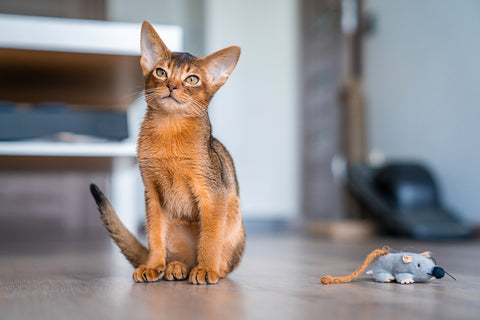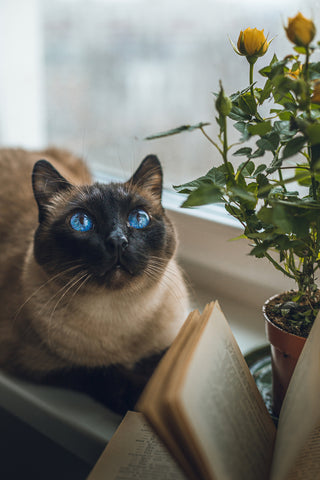
Feline parvovirus is a virus that can cause cats a lot of discomfort. It is also known as feline panleukopenia, feline infectious enteritis (FIE), and feline distemper. Symptoms of feline parvovirus include diarrhea, vomiting, and fever. If left untreated, the virus can lead to severe illness and often proves fatal for kittens. Keep reading to find out not only how cats can get parvo, but also how you can protect your cat safe from parvo.
What Is Parvovirus (Parvo) In Cats?
Parvo is a highly contagious virus that infects host cells quickly in cats. The parvovirus mainly targets the cells in a cat's intestines, which leads to vomiting, diarrhea, and a loss of appetite. However, parvo does not stop at infecting the intestines in cats; it can also go on to attack the bone marrow. Once this feline virus has spread to the cat’s or kitten's bone marrow, it will lead to deficiency of white blood cells, red blood cells, and platelets.
Feline parvovirus is commonly found in most environments and can be extremely hard to eliminate. Most disinfectant products are ineffective against parvovirus, other than bleach, and it can survive even when exposed to hot and cold temperatures.
Kitten parvo is very common, with this contagious virus typically found in cats 3 to 5 months old. However, parvo is also very likely to affect unvaccinated cats and cats with underlying conditions that compromise their health.
How Can Cats Get Parvo?
Unfortunately, there are many ways in which a cat can contract parvovirus. The most common are excrement, urine, and nasal secretions that have come from other cats with the disease. On top of this, fleas can also pass on the virus from one cat to another. Due to this, parvovirus, or feline distemper, can contaminate a range of items and surfaces in and outside your home. Think of bedding, floors, cages, and clothes—it can very quickly spread everywhere.
Furthermore, the feline parvovirus can also be passed directly from one cat to another. However, this is much more common in areas with multiple cats, such as pet shops, animal shelters, and multi-cat households. Unfortunately, pregnant cats that contract the virus are known to give birth to kittens with brain damage that compromises the kittens’ ability to properly walk and eat.
Symptoms Of Parvo In Cats
The first thing you should know about the symptoms caused by parvovirus is your cat will not always display them. In some cases, a cat with the virus may suddenly die without signs of distress or disease.
The symptoms of cat parvo are often seen in kittens, unvaccinated cats, or cats that are not fully vaccinated between the ages of 3 to 5 months. The typical symptoms of cats infected with the parvovirus include the following:
- Vomiting
- Diarrhea - may contain blood
- Frothing at the mouth
- Mild fever
- Dehydration
- Depression
- Loss of appetite
- Lethargy
- Dull, rough coat
- Green/yellow eye and nose discharge
- Loss of skin elasticity
During the early stages of the parvovirus, you may notice that your cat is sitting in front of its food and water bowl, either not consuming either at all or drinking very little. As the virus progresses and grows in severity, your cat may go from having a high temperature to it then dropping below its normal level. At this stage, your cat definitely needs treatment by a veterinarian, as this is a symptom that can prove to be fatal. While there is no specific treatment for parvo, cats displaying any of these symptoms should be seen immediately by a veterinarian, as the disease can continue to spread and without supportive treatment can lead to death (especially in kittens).
Can Cats Get Parvo From Dogs?

According to FETCH by WebMD, the parvovirus that infects dogs doesn’t infect cats. However, “dogs do get infected by a similar virus called the canine parvovirus-2 (CPV-2). The original CPV-2 can't infect cats, but newer variants (CPV-2a, CPV-2b, and CPV-2c) can infect your cat.”
Parvo In Cats Versus Dogs
There are many similarities between parvo in cats and dogs, including the symptoms, how it is spread, and its severity. Despite this, there remain differences between the two different viruses. Below are the listed similarities between feline and canine parvo:
Similarities In Feline & Canine Parvo:
- Both strains are highly contagious
- The virus progresses very quickly
- The virus can prove to be fatal within 48-72 hours after the incubation period
- It may be spread through stool, people, or direct contact with another host
Differences In Feline & Canine Parvo:
- Canine parvo comes in two strains (CPV-1 and CPV-2)
- Canine parvo is treated by boosting the dog’s immune system until they can fight the infection.
- Feline parvo treatment consists of intravenous fluids and antibiotics, but there is no cure.
How Can I Protect My Cat From Parvovirus?

The best way to help protect your cat from feline parvovirus is by vaccination. You should start vaccinating at the age of 8 or 9 weeks. Beginning this early helps protect vulnerable kittens, as feline parvovirus often proves fatal in young kittens. Vaccination doses should be done regularly, three or four weeks apart. You can expect the last vaccination to be done at 16 weeks; a follow-up dose between the ages of 26 and 52 weeks is recommended. It is essential to keep on top of the vaccinations, even when your kitten becomes an adult cat. Booster vaccines are advised to be administered regularly to adult cats.
Diagnosis And Treatment
Feline parvovirus can be challenging to diagnose, as the signs of this disease vary and can be very similar to symptoms associated with other illnesses. These include campylobacter or salmonella infection , pancreatitis, feline immunodeficiency virus (FIV) infection, or feline leukemia virus (FeLV) infection.
Since cat parvo is a common virus, it is best to seek help from your veterinarian immediately. To diagnose this disease, the veterinarian will test the cat’s stool and run a blood test. The results from testing the stool may reveal whether or not parvovirus is present. Additional blood tests yield results showing a reduced number of blood cell types, one of the main characteristics of parvovirus.While there are currently no medicines that can kill the disease, good supportive care can help your cat fight the infection. Your vet will administer supportive fluids, nutrients, and antibiotics to help prevent secondary bacterial infection. Unfortunately, kittens under the age of eight weeks have only a small chance of recovery, while older cats have a greater opportunity if treatment is provided early.
Conclusion
Feline parvovirus is a highly contagious virus that can prove to be fatal for both unvaccinated kittens and adult cats. However, your cat can be provided with the necessary support to fight this virus by keeping them up to date with vaccinations. In addition, spotting the symptoms of cat parvo early is crucial to supporting your cat’s health, so be sure to schedule regular wellness visits with your veterinarian. You can also read our blog about the most common viruses found in cats.
Get Ahead Of Other Health Risks With Basepaws
Basepaws is here to help you get to know your cat better—both inside and out—with our Breed + Health Cat DNA Test and Oral Health Test for Cats, which give you a comprehensive overview of every aspect of your cat's health. Get insight on 25 genetic traits associated with your kitty’s unique appearance and behavior, as well as potentially life-saving information about their blood type and likelihood of resistance to Feline Immunodeficiency Virus (FIV).
In addition to 43 genetic diseases, Basepaws screens your cat's oral health for their current risk of having periodontal disease, halitosis, and tooth resorption. These painful issues are difficult to see, and poor oral health puts your feline friend at risk for heart, kidney, and other health conditions. By knowing what feline diseases your cat may be susceptible to, and how their oral health connects to their overall health, you can be proactive and support your cat’s well-being to help them live a better life, even longer!


